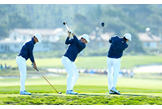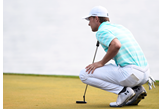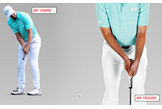Jordan Spieth Instruction: How To Make More Birdies
Published: Last updated:
Jordan Spieth: “To make more birdies you need to do a lot of things right. Here I’ll take you through some tips, from the tee to the green”
How good does it feel to make a birdie? It means you’ve played a hole perfectly – a tee shot into the fairway, an accurate approach and a solid putt. My birdie stats are pretty good. I know I’m not such a prodigious hitter as DJ or Bubba, but power and distance are not everything.
The be-all and end-all is who signs for the lowest scores at the end of the day – and more birdies generally means lower scores. Birdies also give your whole game a boost – club golfers I know get an injection of confidence when they make one. To make more birdies you need to do a lot of things right.
Here I’ll take you through some tips, from the tee to the green.
How To… Hone Your Fairway Finder
Whenever I’m in trouble off the tee and my driver starts to get away from me, I revert back to what I feel comfortable hitting and that’s a soft cut. I call it my fairway finder because it helps to minimises the risk off the tee. Even if I over-cut it – which is the worst-case scenario – the ball will just land a little shorter and right, which on most courses will never get you in trouble.
To set up for a punch cut, I line up on the right side of the tee box, pick out a target on the left side of the fairway and align my body and clubface square to that target line. I then take my normal swing and concentrate on loading the body significantly by completing a full shoulder turn. Once I reach a three-quarter position in the backswing, that’s my cue to start manipulating the downswing and add cut spin. From here, I make a conscious effort to pull across the ball into impact and finish with an abbreviated follow-through to promote that left-to-right movement.

1. SLOW DOWN
Don’t try to smash the cover off the ball. Focus on slowing the body down by swinging within yourself. This will help to keep the club on plane.
2. MAKE ROOM
If I am working a fade, I’ll position myself on the right side of the tee box so I feel like I’ve got extra room to play with down the left side of the fairway.
How To… Leave Yourself More Birdie Putts
STEP 1. Routine is crucial
I like to do a couple of waggles behind the ball just to get my arms moving while I’m talking to Michael [Greller, caddie] about the shot. Then I step back, visualise the shot I want to hit and picture myself hitting it recently on the range or the course.
As I’m stepping up to the ball the club goes down first, square to my target. I look up to align my feet and body square to my clubface and I like to have one swing thought.
From that point I like to be solely focused on the target, and have a ‘trigger’ before I start my swing. Then it’s a case of trying to rotate the clubface, rolling it open as I load into my right side in the backswing, and trying to get it back to square. That’s been my thought process for my good ballstriking and, to be honest, I haven’t reached a level where I don’t have to think about it yet. It’s a good thought for me.
STEP 2. Keep your footing
I’ve worked closely with Under Armour to develop the Spieth 2 shoes, so that I can achieve a firm footing. That’s really important as you set-up and swing. As you swing down into the ball, keep your back foot grounded until after you’ve hit the ball.
STEP 3. Reach for the green
My right arm is fully extended as I swing through (below). I imagine that if I let go of the club, it would fly straight towards the target. A lot of amateurs lose this extension before they hit the ball, which results in poor contact and accuracy. Feel like you’re reaching for the green with the club, and see how much further and straighter your irons go.
How To… Hole The Putt
MY READ
Don’t overthink the mechanics of the stroke. The most important thing is to start looking at the speed and line of the putt. I’ll stalk it from all angles, find the midpoint where the putt breaks and look for a ball mark or a specific piece of grass at the midpoint, which I either want to roll the ball over, next to or around. When I’m confident on my line, I’ll take my address and visualise the arc I want to see. I’ll let that image occupy my mind until my mind goes blank. Only then will I feel comfortable over the ball and in my preparation.

MY TRIGGER
To eliminate tension and feel set over the ball, I have a trigger to begin my stroke which is a forward press. Without it, my hands are level or behind the ball and you can’t putt like that. A little forward press on the handle helps to putt with the right loft and gets the ball rolling smoothly and on the right line.
MY TEMPO
Something I think that is often overlooked with putting is the tempo of the stroke. When I’m knocking in putts from mid-range, my tempo is always equal. From the start to the end of the stroke, it’s almost 1:1. When I watch amateurs, often their tempo is 3:2 because they move away from a pendulum motion and start manipulating the face with the hands. The key is to rock the shoulders at the same tempo, so the putter face opens and closes at the same rate.

How To… Pitch With Spin
The “one stop and hop” pitch is a difficult shot to execute – probably one of the hardest – but it’s one of my favourites, especially when playing a links course. And it will help you set up more birdie chances on par 5s and shorter par 4s. Whenever I’m faced with a half pitch to a tight pin and/ or a super-fast green, this is my go-to shot because it’s the easiest to control the distance. The problem is that it goes against convention and how you might expect to play it. But if you can fight your natural instincts and set-up like so, you’ll breathe new life into your short game and approach those awkward, in-between shots with confidence.
STEP 1. Using a high lofted wedge – mine is 60° – take a narrow stance, ball in the centre, and stand square to the target with your weight forward and the clubface slightly open. This will automatically promote a descending angle of attack – the key to generating spin.
STEP 2. Make a half swing by hinging the wrists to the max and then unwind by feeling like you’re cutting low and across the ball – almost mimicking a cut shot. To maximise spin, keep the clubhead low to the ground for as long as possible after impact.
BOW YOUR WRIST
For a lower trajectory, finish with the left wrist pointing at the target.
TAKE A DIVOT
Speed is the key to success here, so be aggressive, accelerate into impact and try to trap the ball into the turf.






